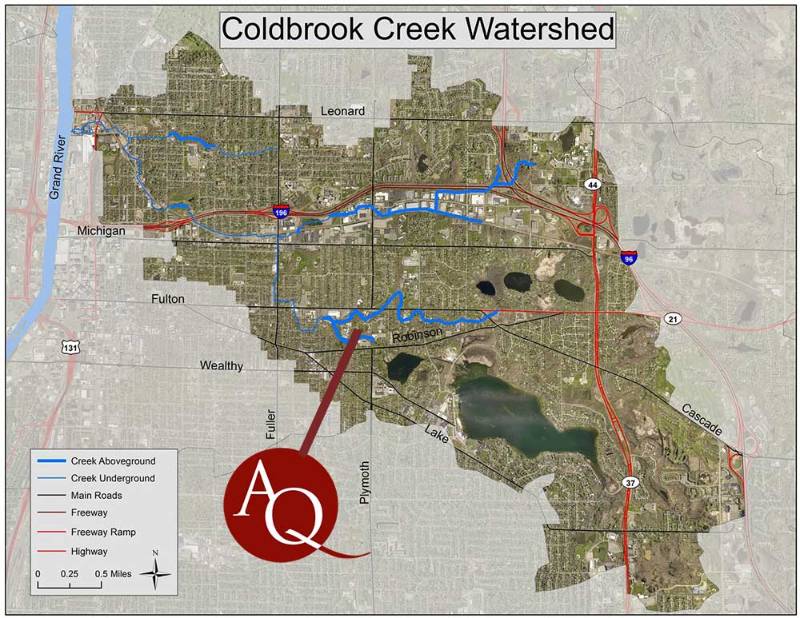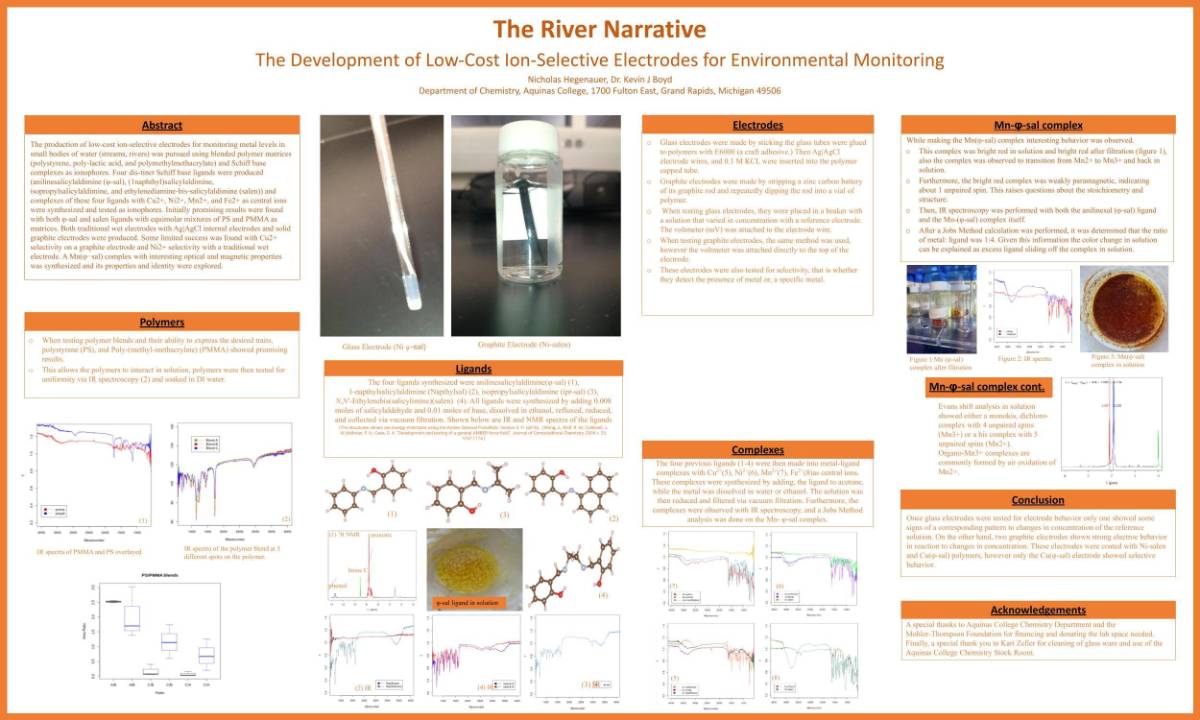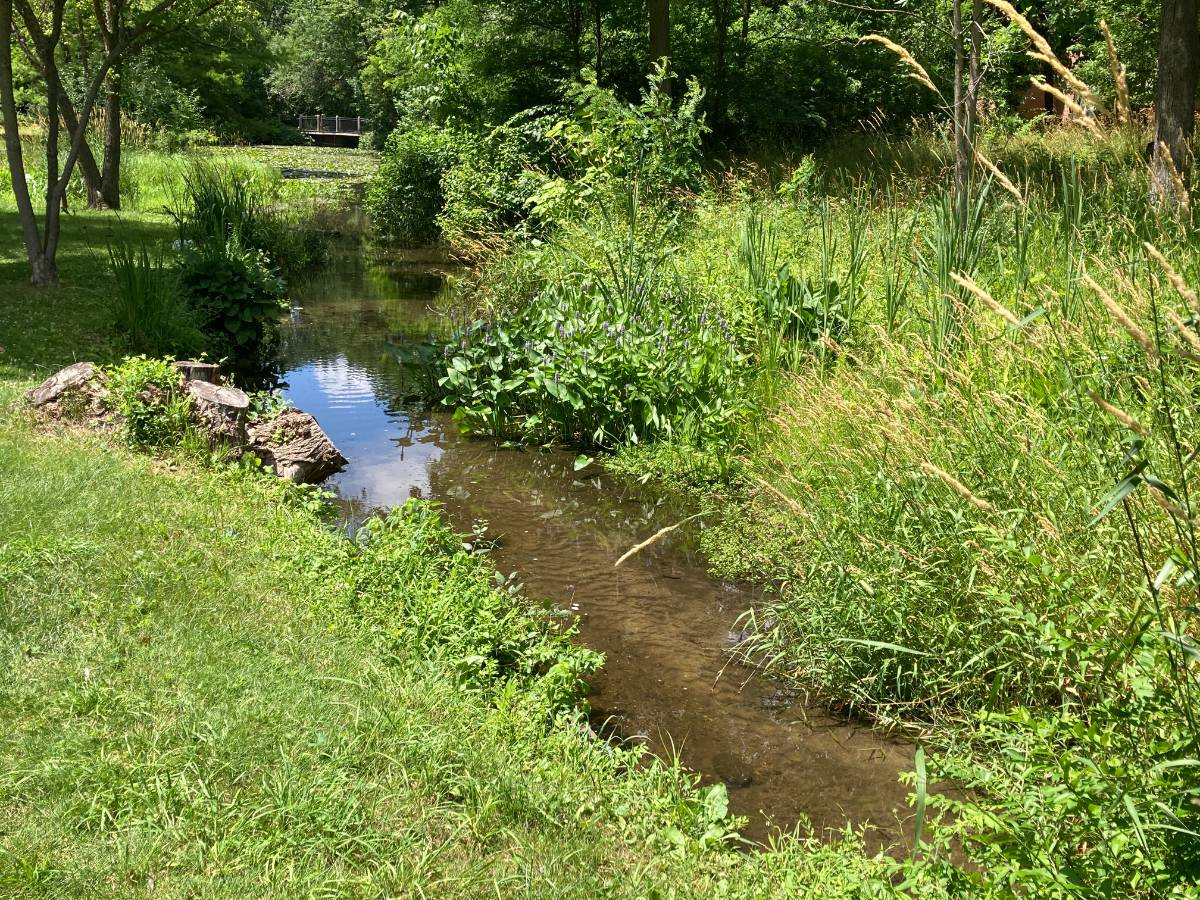The next stage of the River Narrative Project is underway this summer!
Dr. Kevin Boyd recently received additional funding from the Economicology Leadership Fund (ELF) for the River Narrative Project. This project aims to install and tweak a real-time sensor network in Coldbrook Creek that will provide additional data to a database. These sensors will be placed at multiple locations along Coldbrook Creek to monitor chemical indicators of stream health.
They will then share the data through a website and local access points, enhancing public understanding of the stream's history, legends and current data regarding the stream chemistry. “The idea is that the river has a story to tell, and you’re just filling in the details,” states Dr. Boyd.
About the Narrative River Project
The goal of the project is to gain insight into what’s going on in the stream at any given time. “The stream is fed from Fisk Lake and Reed’s Lake, surrounded by million-dollar homes, with million-dollar lawns. And every spring, those guys pour fertilizer out there. They pour whatever out there to control weeds. All that runs off into the lake, into the stream and moves downstream. So if we can watch all that, we can see what’s going on, and we can work with people to devise strategies to minimize the damage done and make sure we keep the stream healthy,” Dr. Boyd explains.
The mission is about protecting the stream's health and connecting people to its history. By using sensors that double as wireless access points, he aims to create a local network filled with pictures, stories and the history of the stream. Visitors can tap into this network to learn about the stream's past, understand its current state and see the efforts made to preserve it.
Mary and Pete Lewandowski and the Coldbrook Creek Community
Mary and Pete Lewandowski are the driving force behind the Coldbrook Creek Community, a local group interested in the history and health of Coldbrook Creek. They have provided old photos from their historical archives, and they even gave a talk on campus last year about the history of Coldbrook Creek, where they brought in pictures and maps of what it was before. According to Dr. Boyd, the Creek wasn’t always mostly underground.
The Coldbrook Creek community also visits campus to take quarterly measurements of PH, temperature, dissolved oxygen and conductivity (a measure of salt content). To take these measurements, they partner with LGROW, a collection of groups committed to protecting the Lower Grand River Watershed and the streams that feed into it.
They also have a community following, so Dr. Boyd and his students have been working with them to share data and make resources accessible.

Summer 2022 Accomplishments
Nick Hegenauer ‘24 was the first student to receive Mohler-Thompson Summer Research Scholars funds for the River Narrative Project in the summer of 2022. According to Nick, a lot of the work he did was figuring out the best components to help them decipher which chemicals and metals were in the river.
“(Dr. Boyd) would read and find out what compounds would have the best properties for this project. I was doing dilutions, figuring out which dilutions were best for the solution and which electrodes were best for us to use. I worked with a lot of distillations, and I did a lot of spectrometry too since that’s how we determined if they were good enough,” Nick explains.
While they didn’t put sensors into the river, they did a lot of the original research on how to build the sensors and identified several ion-selective electrodes that were needed for environmental monitoring. Both of these accomplishments created a framework for future student research.

Database and Website Setup
Last January, Dr. Boyd set up the computer database for a student who wanted to work with CO2 monitoring on the Creek. He explains that, despite being put together in a hurry for this student, the sensor could successfully collect and write data and send it back to the database. He describes it as, “functional, but ugly.”
This past spring, he received funding from ELM for Beau Craig, a computer information science major, to clean up and document the code and then better organize that data on the website. Dr. Boyd remarked, “As you may expect when you write something in a hurry, it’s sort of a jumbled mess of things. A better structure and clarity will help (us maintain it better.)”
Beau is currently finishing up his work this summer, so future data will soon be transmitted in a more user-friendly way.
Looking Ahead to Summer 2024
This summer, Ella Satterthwaite, a sophomore, will work on the project through the Mohler-Thompson Summer Research grant. She began on Monday, June 3. So far, she has been running manual water tests on samples and building instrumentation that she will use throughout the summer to run baseline water testing.
According to Ella, “The main point of the project is to characterize the river further, so we’re primarily doing that with electrochemical sensors among other things. That’s what we’re doing with the circuit. We’re taking the electrochemical sensor, which will be an electrode, and the electrode will detect metals and pesticide content in the water. The signal from that electrode is amplified through the circuit board. It’s transferred to a computer chip, called a microcontroller, and that microcontroller has a small sub-gigahertz radio chip, which will transmit data back to Albertus. So, we’ll be reading the data from the sensors that way.”
Ella further explained that using electrodes to measure metals and chemicals will expedite the process of water testing. She explained that manually testing water was very labor-intensive.
“I’ll give you a comparison,” Ella illustrates. “For the past two days this week, I collected 10 samples from around the campus, different parts of the water. That probably took me 2 hours to walk around, and I was also doing some pH and temperature readings and making other observations.”
From there, Ella spent a few days working on testing the samples that she took. Aside from the quarterly measurements taken by the Coldbrook Creek Community, this process is currently too time-consuming to send out student workers continuously. The sensors will therefore allow for more tests to be done quickly, saving time and creating a fuller picture of the river’s narrative.
“The next piece is to put more sensors up and down the stream,” explains Dr. Boyd. Each sensor will be able to measure a different metal or chemical, so they can track more data than what’s feasible with manual testing.
They hope to begin setting up the sensors and transmitting data over to the website this summer.

What is the Economicology Leadership Fund (ELF)?
The Economicology Leadership Fund provides flexible funding available at the discretion of AQ’s president or her designee. Its primary purpose is to support innovative research and program development initiatives that advance the concept of Economicology, defined by Peter Wege as the aspiration to “create a balance of livability between our ecology and the economy” (Economicology II, 17). Proposals may originate from various sources within the campus community, including faculty, staff, committees, and strategic planning processes.
